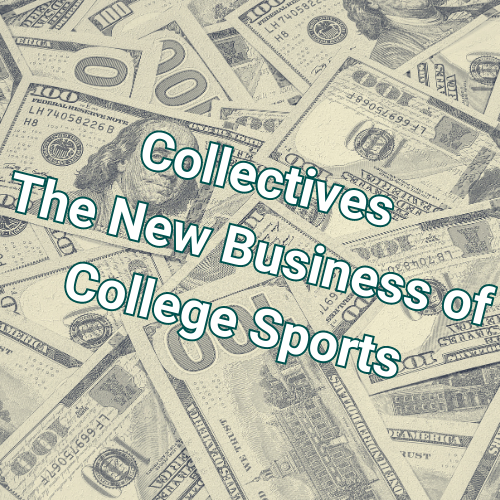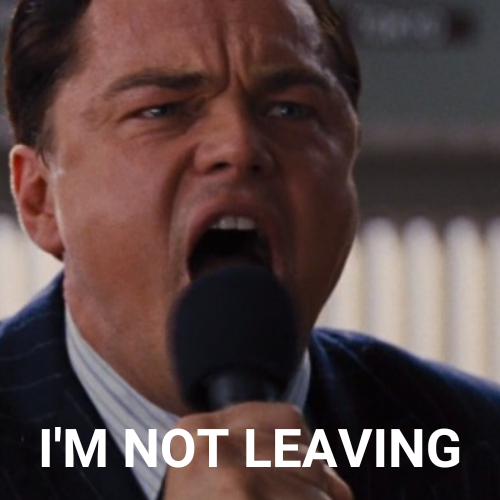What are Collectives & How do they benefit players?
WHAT ARE the BASICS OF COLLECTIVES?
At their most basic core, collectives are businesses that generate pools of money from boosters and businesses to help facilitate NIL deals for athletes. They are usually school specific and allow those athletes to use the collective’s own platform to monetize that athlete’s individual brand.
The main reason that school boosters have adopted the “collective model” is because it allows for the collectives to keep up to 100% of the profits which means more money to distribute to their athletes.
You might ask yourself, “What’s going on here, I thought college athletes couldn’t get paid… Is this shady business or is this all above board?”
The answers are essentially, YES, players can now be paid (most of the time) and YES, this is all above board, (except for when it isn’t...)
While all of this is confusing, it makes a lot more sense when you see how we got to where we are in the crazy world of college sports in 2023.

HOW DID WE GET HERE & IS ALL OF THIS EVEN LEGAL?
The story of how we get to collectives revolves around the NCAA’s reluctance to allow college athletes to get paid at the risk of losing the “Amateur” nature of college sports.
The history of collegiate sports has its roots grounded in the principles of amateurism. Amateurism has historically been marred by the fact that large institutions like the NCAA, cable networks, and others in the entertainment industry have been profiting off of the work of student-athletes without those athletes being compensated for their efforts.
The first instance of athletes fighting for their rights to profit from their athletic achievements came in the late 2000s when Ed O’Bannon, a former UCLA basketball player, and 19 other athletes sued the NCAA for using their name, image, and likeness in the NCAA video games.
The athletes argued that the NCAA and EA Sport’s actions denying them revenue generated from their name, image, and likeness in broadcasts and video games was a violation of the United States antitrust laws, and after years of litigation, the court agreed with the student-athletes.

It wasn’t until years later that collegiate athletes really made some headway in the realm of making money in relation to their name, image, and likeness, and we have Shawne Alston to thank for that. (Hat tip to you, Sir.)
In 2009, Shawne Alston, a former West Virginia running back, sued the NCAA because the long-standing amateurism rules restricted the types and amounts of benefits that colleges could offer to student-athletes beyond traditional tuition, room and board, and books. In Alston’s case, he wanted to receive a grant but was unable to due to an artificial cap imposed by the NCAA.
While Alston’s victory was obviously important, arguably the most significant outcome from Alston’s case came from Justice Kavanaugh’s concurring opinion. There, Kavanaugh called out the NCAA by saying, “Nowhere else in America can businesses get away with agreeing not to pay their workers a fair market rate on the theory that their product is defined by not paying their workers a fair market rate,” and that there is no reason why college sports should be treated any differently.
And to make sure to leave zero doubt about the seriousness of his opinion, he even went on to say that “the NCAA is not above the law.” As Michael Scott said, “BOOM, roasted!”
Because of Alston and the Supreme Court’s clearly strong opinion that the NCAA doesn’t possess the powers that the NCAA thought that it did (sorry ‘bout it), the NCAA’s Board of Directors implemented an interim NIL rule on July 1, 2021. This made it so that student-athletes can earn money by partnering with brands through NIL opportunities.
Officially, the decision to allow athletes to profit from their NIL was driven by a desire for fairness and to address concerns regarding the exploitation of athletes’ identities for financial gain by others, but really, the NCAA was backed into a corner and had no other option than to change. All in all, this was a monumental dub for team student-athlete.
Okay, cool. Now that we know that all of this is above board, does it really matter?? Are there really that many schools that have NIL Collectives?
ARE COLLECTIVES HERE TO STAY?

The answer is a resounding YES! To date, there are more than 200 collectives that are already formed or are in the process of formation.
Virtually every Power 5 school has an NIL Collective, and each school certainly feels the need to have one in this day in age. If they don’t, they run a serious risk of being left behind.
For example, if you're a college athlete and have the ability to profit from your athletic ability while in college, why wouldn’t you choose the school that had a greater chance of making you more money?
And while there are obviously many intangible reasons that some people prefer one school to another, it is understandable that the financial benefits could easily be the determining factor for many collegiate athletes.
This leads us to the greatest concern over NIL Collectives, the inducements and pay-to-play in recruiting, and the transfer portal.
This is a very, very tricky question to answer because NIL Collectives are so new and there are no examples of how the NCAA could punish schools or if they have the authority to regulate these collectives in the first place. For now, all we know is that the NCAA probably has the authority to try and prevent schools from using NIL Collectives to recruit players from the high school ranks and from the transfer portal.
However, whether the NCAA would be successful in its approach to regulate the collectives is yet to be determined.
On top of the legal problems the NCAA already faces, what’s left of their regulatory authority is limited even further by state legislatures openly crafting laws that provide their state’s schools to have a leg up on the competition in the NIL race.
Looking at you Arkansas, Texas, Oklahoma, and Missouri...
And from what we know about the competitive tenacity of collegiate sports, it seems almost inevitable that other states will follow suit and pass similar laws. Plain and simple, the genie is out of the bottle.
Collegiate athletes now can profit from their name, image, and likeness, and there doesn’t appear to be a clear route the NCAA can take to grab back some of that control.
Now that it seems almost obvious that college athletes’ NIL rights are here to stay, how do these Collectives actually work?
HOW DO NIL COLLECTIVES WORK?
NIL Collectives are typically structured as for-profit businesses although there are a few that operate as non-profit. For the most part, though, these collectives are for-profit businesses.
While the ownership structure of each collective may vary from school to school, most collectives are run by boosters and alumni of the school that the collective benefits.
To date, there are three main ways in which boosters, fans, and sports fanatics are generating funds and spending money to distribute to student-athletes through marketplace collectives, donor-driven collectives, and dual collectives. You might ask though, how are these people actually getting the money to student-athletes, and what are these people getting in return?
The answer ultimately depends on the person spending the money. If a booster is donating money, they’ll most likely donate to a donor-driven collective. For fanatic sports fans who love collecting all manner of sports memorabilia, a marketplace collective is a great location. And for a parent who wants to snag their kid’s favorite college quarterback’s jersey, then they’ll probably go to a dual collective that would fit the bill of that person.
Here’s a breakdown of the main types of collectives and how they operate.
1. MARKETPLACE COLLECTIVES
Marketplace collectives generate funds by creating spaces for fans to have the opportunity to purchase certain products or services directly from student-athletes. Some collectives have their own marketplace collective sites that are like a school’s gift shop. These sites sell their athletes’ branded apparel, signed sports cards and memorabilia, and a manner of other products and social media interactions that an athlete wishes to participate in.
There are also companies like Opendorse and INFLCR that have quickly become two of the largest companies to take control of these markets for schools that either don’t have the means or booster support to host their own marketplace collective cite and schools that use these sites in conjunction with their donor-driven collectives.
- INFLCR - Primarily connects prospective businesses to student-athletes and INFLCR does not charge the student-athlete for any money that they may receive from their endorsements. Instead, INFLCR makes its money by contracting with individual schools to host their student-athletes on their site. INFLCR works by having four different exchanges of marketplaces that live in the INFLCR exchange. Those four exchanges are endorsements, digital, products, and training.
- Opendorse - Works by allowing athletes to browse and apply to pre-built offers from businesses that wish to have athletes from a particular school represent them, then the businesses choose which athlete they want, negotiate a fair deal, and begin the working relationship.
2. DONOR-DRIVEN COLLECTIVES
Donor-driven collectives receive donated funds from boosters and businesses, and they facilitate NIL deals between the athletes and these companies, ultimately resulting in the athletes receiving payment for their NIL usage. This seems to be the most common new type of collective used by many of the larger schools (think SEC and other large Power 5 schools).
Most of the donor-driven collectives are not legally connected to their respective schools. However, as mentioned above, there are a few states that have transitioned to in-house donor-driven collectives (Texas A&M for instance).
It’s important to remember though that because donor-driven collectives are for-profit businesses, there is still a very real risk that student-athletes will be taken advantage of and not paid the maximum of what that athlete might be worth.
After all, it’s in the collective’s best interest to keep as much money in the collective as possible to distribute (and maybe entice if we’re operating outside legal bounds as many expect some are doing) to a great athlete for their performance.
The bargaining conversations between the collective representatives and the athlete often lead to very awkward interactions.
For example, if an athlete is offered a certain amount of money from the collective and that athlete believes that amount to be too low, that interaction can have a seriously negative impact on the player and even leave the athlete feeling unappreciated by the school itself. To prevent souring relationships, it is definitely recommended that an athlete have someone working on their behalf for these types of negotiations, or really any negotiations at all in which the athlete is bargaining to be compensated for their efforts.
Suffice to say, Duality Sports does just that.
3. DUAL COLLECTIVES
Dual collectives are, you guessed it, a combination of a marketplace collective and a donor-driven collective.
These were created to combine the benefits of both other types of collectives and to provide a single destination for donors to have the ability to contribute to the success of their athletes in one location. These are becoming more and more prevalent and essentially bring the entire aspect of an athlete’s NIL opportunities under one roof.
All three types of collectives offer different ways for fans of their school to contribute to the success of their programs.
For years fans have been clamoring for the opportunity to get directly and personally involved to the success of their programs by supporting their student-athletes and with the advent of NIL Collectives, those fans now have the opportunity to do just that.
While no one knows what the future holds, it appears that NIL Collectives are here to stay.
John Conal Schultz
